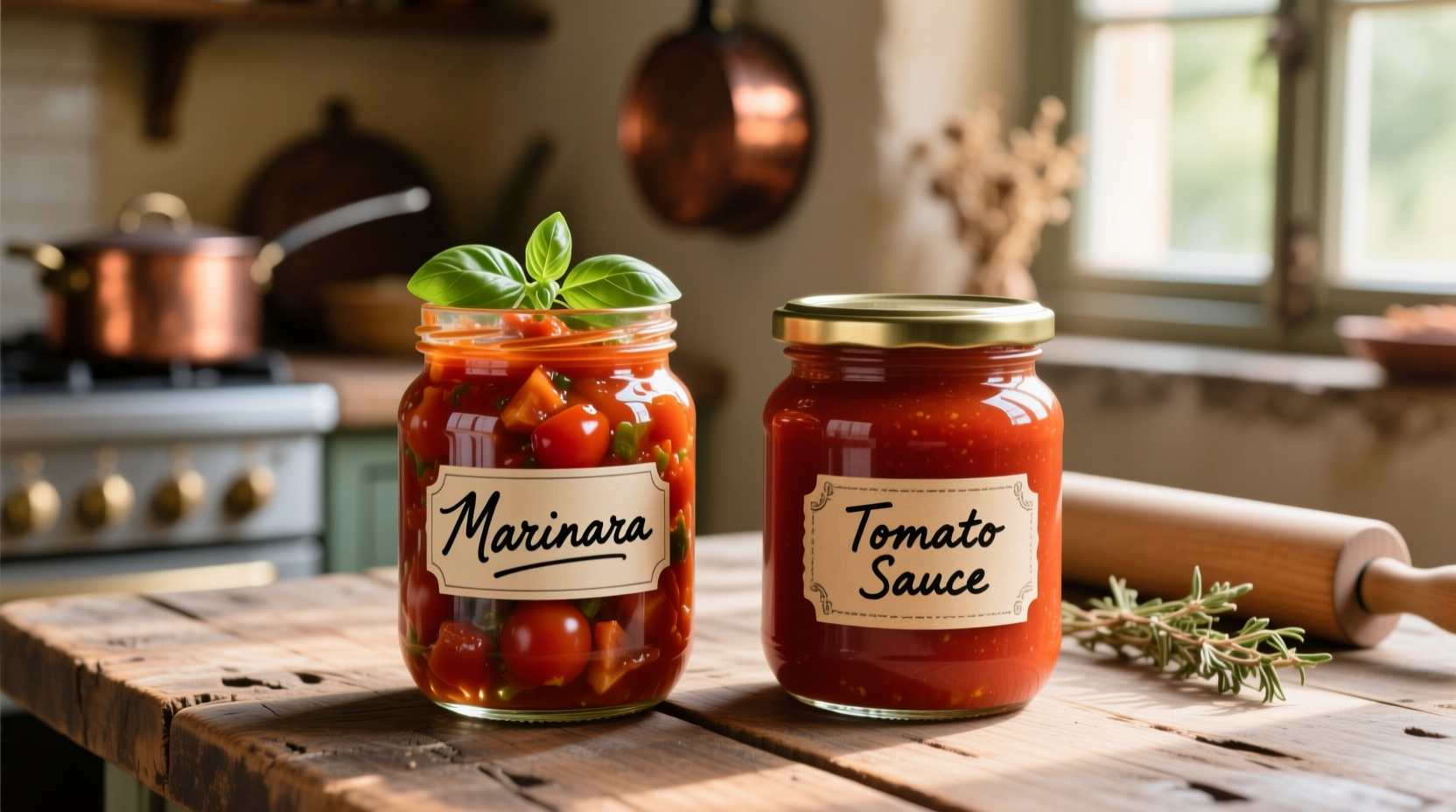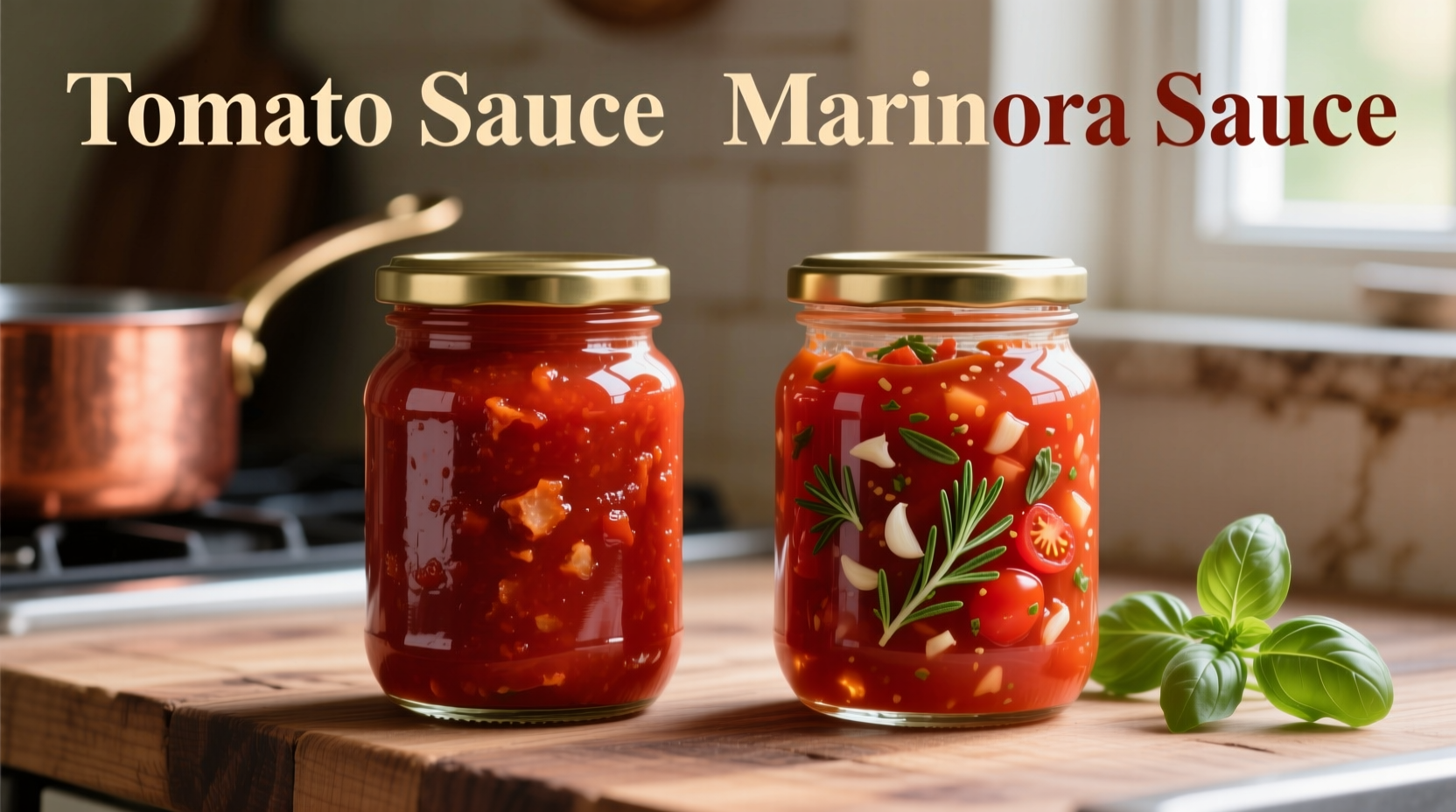Understanding the Real Difference Between Tomato Sauce and Marinara
Many home cooks use “tomato sauce” and “marinara” interchangeably, but these Italian staples have distinct characteristics that affect your cooking results. Knowing when to reach for each can transform your pasta dishes from ordinary to authentic.
Why This Confusion Exists
The confusion stems from inconsistent labeling in American supermarkets, where “pasta sauce” often refers to both. In Italy, these terms have precise meanings rooted in regional cooking traditions. Let's clarify exactly what sets them apart.
Core Differences at a Glance
| Characteristic | Marinara Sauce | Tomato Sauce |
|---|---|---|
| Preparation Time | 20-30 minutes | 2-6 hours |
| Key Ingredients | Tomatoes, garlic, olive oil, oregano/basil, salt | Tomatoes, onions, carrots, celery, wine, meat stock, herbs |
| Texture | Bright, slightly chunky | Smooth, velvety |
| Cooking Method | Quick sauté and simmer | Slow reduction |
| Flavor Profile | Fresh, acidic, herb-forward | Complex, deep, umami-rich |
The Historical Evolution of These Classic Sauces
Understanding the timeline of these sauces reveals why they developed differently:
Marinara's Origins (Late 16th Century)
Created by Neapolitan sailors (“marinai”) who needed quick meals between voyages. The name literally means “seafarer's sauce.” Historical records from Accademia Italiana della Cucina confirm marinara's simple preparation was designed for speed using pantry staples.
Tomato Sauce Development (19th Century)
Emerged as tomatoes became central to Italian cuisine. The Italian Academy of Cuisine documents how home cooks developed slow-simmered tomato sauces using soffritto (onion, carrot, celery) to create richer flavor bases for complex dishes.
When to Use Each Sauce: Practical Guidance
Choosing the right sauce depends on your dish and available time:
Reach for Marinara When:
- You need a quick weeknight meal (ready in 30 minutes)
- Preparing pizza or flatbreads
- Creating seafood pasta dishes (its lightness complements fish)
- You want to highlight fresh tomato flavor
Choose Tomato Sauce When:
- Preparing lasagna or baked pasta dishes
- Need a sauce that will simmer with meat (like in ragù)
- Creating dishes requiring deeper flavor complexity
- You have time for slow cooking (2+ hours)

Common Misconceptions Clarified
“Marinara is just a type of tomato sauce” – While technically true in the broadest sense, this oversimplification misses crucial distinctions. In professional Italian kitchens, these are considered separate preparations with specific uses.
“All jarred ‘pasta sauce’ is the same” – Supermarket labeling often misrepresents these sauces. Check ingredients: authentic marinara should have minimal components, while tomato sauce will list more vegetables and longer cooking instructions.
Creating Authentic Versions at Home
Perfect Marinara in 25 Minutes: Sauté garlic in olive oil, add crushed San Marzano tomatoes, a pinch of red pepper flakes, and fresh basil. Simmer 20 minutes. The Gambero Rosso Culinary Institute emphasizes using unripe tomatoes for authentic marinara's bright acidity.
Traditional Tomato Sauce: Start with soffritto (onion, carrot, celery), add tomato passata, a splash of wine, and simmer 3-4 hours. As documented by Fondazione Magnaghi, the slow reduction develops the characteristic rich, rounded flavor.
Substitution Guidelines
While not ideal, substitutions work in specific contexts:
- Use marinara as base for tomato sauce (add soffritto and simmer longer)
- Thin tomato sauce with tomato water for marinara-like consistency
- Never substitute tomato sauce for marinara in seafood dishes (overpowers delicate flavors)
Regional Variations to Know
Italian regional differences affect these sauces:
- Southern Italy: Marinara often includes oregano
- Northern Italy: Tomato sauce frequently incorporates carrot and celery
- Rome: Marinara sometimes includes a splash of red wine
- Sicily: Tomato sauce often features capers and olives
Frequently Asked Questions
Can I use marinara sauce for pizza?
Yes, authentic Neapolitan pizza traditionally uses marinara sauce. Its quick preparation and bright flavor complement the short baking time of pizza, unlike slower-cooked tomato sauces which would burn.
Why does marinara have no onions while tomato sauce does?
Marinara's origins as a quick sailor's meal meant using only pantry staples without time for chopping. Traditional tomato sauce developed as a Sunday dish where taking time to prepare soffritto (onion, carrot, celery) created deeper flavor foundations for slow cooking.
What's the best tomato variety for authentic marinara?
San Marzano tomatoes from Italy's Sarnese-Nocerino region are preferred for authentic marinara. The Consorzio del Pomodoro San Marzano documentation shows these tomatoes have the perfect balance of sweetness and acidity without needing additional sugar.
How can I tell if store-bought sauce is authentic marinara?
Check the ingredient list: authentic marinara should contain only tomatoes, garlic, olive oil, herbs, and salt—no onions, carrots, celery, or sugar. The label should indicate “quick-cooked” rather than “long-simmered.”
Does marinara sauce always contain seafood?
No, despite the “marinara” (sea) name, traditional marinara sauce contains no seafood. The name refers to its origins with sailors, not ingredients. Seafood is added separately when preparing dishes like spaghetti alle vongole.











 浙公网安备
33010002000092号
浙公网安备
33010002000092号 浙B2-20120091-4
浙B2-20120091-4